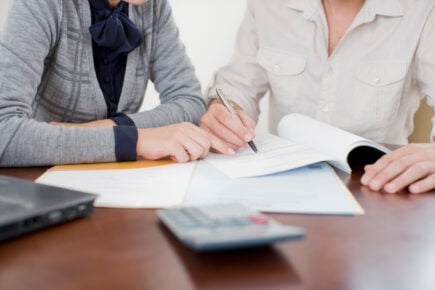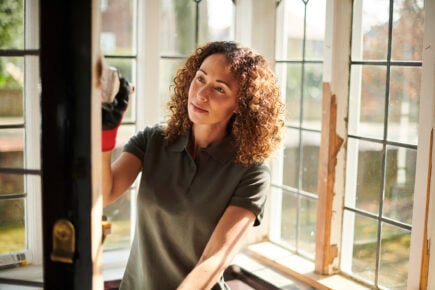Becoming a homeowner may seem daunting when you take into account everything you need to do to make it a reality.
Buying a house requires discipline and patience, but following a step-by-step guide from the outset should demystify the entire process and you may hopefully even have some fun along the way.
Below is a 12-step guide to provide you with a comprehensive understanding of what to expect during the process.
How to buy a house in Australia
1. Decide to buy
Making a decision to purchase property means you feel ready to take on a major financial commitment, probably for the first time. Home loans in Australia last for periods of between 20 and 30 years, which can seem like an eternity to someone who is younger or who has never taken on long-term debt.
Getting into the property market isn’t a decision you can make in isolation either, because it involves every aspect of your life. If you have a partner, for example, you’ll need to decide whether it’s something you’re both ready to commit to — emotionally and financially.
You’ll also need to consider whether you want to have a family and what effect that may have on your future finances. If you can only rely on one income for a period of time it may affect your ability to make the payments on a mortgage that you qualified for using two incomes.
Taking on a mortgage may also involve a change in your standard of living, in the short term at least, especially if you’re used to renting in a nice part of the city for less than your mortgage repayments will be.
In the long-term, homeownership offers the potential for financial growth and an expanded lifestyle, you just have to consider whether now is the right time to buy.
2. Get your finances in order
When looking at your financial readiness for homeownership, the first thing you’ll need to check is your potential to withstand the things that could go wrong over the course of a 20-year mortgage, with as much certainty as possible.
Home loans have two major components; the house deposit (a percentage of the property’s cost payable up front) and the remainder of the amount borrowed — or principal — payable over an agreed-upon timeframe with the lender, usually between 20 and 30 years.
Being ready financially means you’ve saved up most or all of the deposit, which is usually 20% of the property’s value, but sometimes less, and feel confident that you’ll be able to make regular repayments over fortnightly or monthly periods for the remainder of the amount.
A checklist of your finances should include:
- Your regular income from your principal mode of employment.
- Any other income you derive regularly from side projects, casual work or investments.
- Your monthly expenditures.
Start with monthly income, but remember to only use the after-tax amount. Once you’ve added anything else you may get regularly from investments, assets or other work, you’ll need to determine your expenditure, though if you are currently renting exclude that amount because that’s money that would otherwise be going towards the mortgage repayments.
You should also start a budget to see how much you can afford to pay off when it comes to mortgage repayments and how much this leaves you at the end of every month.
Once you’ve done some calculations over a six-month period at least, for example, and you see that your total income is $8000 a month and your expenses (excluding rent) are $3000, you will arrive simply at an amount of $5000 a month that could be put towards mortgage repayments.
3. See how much you can borrow
Once you have determined how much you can comfortably make on repayments, you need to work out how much you can borrow.
This amount will be different among lenders, all of whom should have online borrowing calculators so you can at least get a ballpark figure by typing in a few variables. You could even start off with the bank you already have an account with.
So, taking the above example, if you bank with the Commonwealth Bank, you could use its borrowing capacity calculator and key in an income of $80,000 with just $1,200 in monthly living expenses to get a potential mortgage amount of $449,700.
What this example doesn’t take into account are your individual credit score/rating, any credit card or personal loan debt you may have, or rising interest rates. But when you apply to a lender, they will consider these factors.
It’s typically best to talk to a mortgage broker or financial planner to work out the right amount for you to borrow.
4. Make a plan for the deposit and look for grants
Lenders in Australia generally require a 20% deposit, without which you would be liable for lenders mortgage insurance. Once you have an idea of your borrowing capacity, saving for a deposit should be your number one priority.
Saving for a deposit provides would-be lenders with evidence of financial discipline and reduces the amount you have to borrow, but saving up 20% of a home at today’s prices can be extremely hard. Even with a partner it could take years, and many would-be homeowners are undoubtedly put off by this requirement.
Thankfully, there are ways around this, such as finding a guarantor for your loan. You could also look at types of home loans that allow smaller deposits.
You can also apply for a range of incentives offered by federal and state governments such as the First Home Owners Grant, which will at least go some way to covering the cost of the deposit. Go directly to your state government’s official website to see exactly what you’re entitled to.
Speak to a mortgage broker or a financial adviser about your deposit options and look at ways to save for a full deposit faster if that remains your only option.
5. Choose the right mortgage for you
Once you know what you can borrow and you’ve got your deposit together, it’s time to shop around for a mortgage lender.
You may have banked with one of the big four banks your entire life and have family connections there, so checking out its offerings is a logical starting point, but you shouldn’t feel wedded to your current bank if you can find a better deal elsewhere.
Talking to a mortgage broker may be a good first step, given they often represent several lenders and can do research on your behalf. They should also have an opinion of what type of loan best suits your situation. Without the help of experts it can be overwhelming, given the number of different loans available.
When comparing mortgage options, finding a lower interest rate, which is usually on offer for at least the first 12 months of a mortgage but often longer, is obviously important. Also look for things such as zero establishment fees, ways to use frequent flyer points, if possible, and facilities such as redraw and offset.
6. Get pre-approved
Once you’ve settled on a lender and found the mortgage that suits you best, you’ll need mortgage pre-approval. This is the step where you go from guessing how much you might be able to borrow, to knowing what a real lender is willing to let you borrow. If you satisfy the lending criteria, this shouldn’t be a problem, and pre-approval lasts usually between 3 to 6 months.
Pre-approval differs between lenders but it typically means you have satisfied the preliminary qualification criteria for borrowing a mortgage, and you’re good to go ahead and make an offer or bid at an auction up to the approved amount.Full pre-approval usually requires a valuation, like all mortgages, to ensure the buyer is not paying way too much for the property.
Getting mortgage pre-approval does not mean you are committed to a particular loan, but it does give a reasonable price range with which to work.
If you struggle to find a suitable property in the pre-approval period, you can contact your lender for an extension, which should not be a problem if your circumstances haven’t changed, so you don’t have to re-apply for the loan.
7. Start shopping for a house
Once you’re pre-approved, it’s time to get out there and start looking. At this stage you’ll probably have a list of prerequisites regarding features and location. Knowing what you want is important, just remember it’s unlikely you’ll get everything you want in a single home — particularly if it’s your first.
Compile a must-have list for things such as size, layout, and the extent of renovation required, and things you can live without, such as nice fittings and outdoor areas.
Once you’ve settled on a location, start by looking at listings online and in local newspapers, and check local real estate agent websites to get an idea of what you’ll get in your price range.
You can then go to open inspections or ask agents to show you properties, while also being mindful of what you can borrow, so don’t waste your time looking at $500,000 properties if you’ve only been pre-approved for a $400,000 loan.
8. Schedule a building and pest inspection
Once you’ve found a property that ticks your boxes, you may need a building and pet inspection and an appraisal. This will depend on a range of factors, such as when the last time one was conducted on the property and how up-to-date it is. There will often also be a report contained in the title search, but not always, so check with your solicitor first.
Buying an apartment is generally easier because there should be regular strata reports about the building’s condition and what repairs are required. If, for example, the common areas require $5000 from every unit owner for things such as painting you can negotiate your price with the seller to factor this in.
If you are bidding at auction, information on the state of the property should be readily available, often for a search fee.
There are times, however, when getting an inspection, which should never cost more than a couple of hundred bucks maximum, is essential for peace-of-mind and may save you a fortune down the track if it uncovers issues with structure, wiring, or rising damp, for example.
If an inspection does uncover anything likely to cost you a lot to fix you can always negotiate with the seller or just look for another place if it isn’t worth the money, time, and aggravation to fix.
It is also worth getting a pest inspection to check that there is no termite or other insect activity that could cause long-term damage to the walls or ceilings.
9. Make an offer or attend an auction
At this point, once you’re satisfied with the property and your finances are in order, it’s time to make an offer or attend an auction.
When negotiating, you need to know exactly what your limit is to avoid any potential embarrassment and to also be flexible so you don’t lose the property you want.
As a home buyer, you can make a conditional offer subject to bank valuation, financial approval and inspections, and an unconditional one, where the above prerequisites have been met. As a first-home buyer, it is recommended that you get the above points taken care of first, however, unless you’ve already started looking and have fallen in love with a property before you’ve got the full go-ahead including the bank valuation. Just remember that this offer remains conditional and someone might put in a bigger offer in the meantime as you’re in no position to immediately make the purchase.
If you’re bidding at auction, it might be worth attending a few beforehand to familiarise yourself with the process, and to not get swept up in the excitement and go over your limit. Prior to auction you should have checked out the property on hopefully a few occasions but you also need to be wary of the price expectations given by agents, which are often much lower than the real value just to entice more would-be bidders. Check out the prices of recent sales to make sure you aren’t wasting your time bidding for something out of your price range.
Unlike private treaties, where you can usually get out of your contract if something unforeseen happens and you’ll get most of your deposit back, there is no cooling off period with auctions so you need to be sure that you want the property and that you know exactly how much you can bid beforehand because you could lose your deposit if you have a change of heart.
Expect to pay between 5-10% of the winning bid as a deposit at the conclusion of the auction, though this shouldn’t be an issue because your lender will have given you pre-approval to bid up to a certain amount so you’re armed with a deposit bond.
10. Exchange contracts and pay the deposit
Once you’ve agreed on a price with the seller or successfully bid at auction, you’re tantalisingly close to obtaining your property.
The final step before buying is to get a copy of the contract and to get your solicitor to check it to ensure everything is as agreed and there are no hidden surprises that need to be addressed before you can exchange.
Once the contract looks fine, you can now go ahead with the conveyancing, where the property title is transferred from the seller to you. Your solicitor should be well acquainted with the procedure so there are no legal complications that arise down the track regarding who actually owns the property and whether there is any debt associated with it. Your solicitor will also advise you of the stamp duty payable on the property, which becomes due on the exchange of contracts.
You can then sign the contract of sale with the seller, pay your deposit and wait until the agreed-upon settlement date, usually six weeks after contracts are exchanged, but sometimes shorter or longer, depending on what you agree on.
Finally, it is a good idea to have your home insurance in place at the time of exchange, and some lenders may require this as a prerequisite to lending you the money in the first place.
11. Settle on the contract and move in
Settlement on the property is the date in which the title is transferred into your name, the remainder of the agreed-upon price is transferred from your solicitor to the seller, and the keys are handed over.
You are now the proud owner of your property and your mortgage repayments begin.
12. Re-evaluate your mortgage on a regular basis
You may not be able to do much with the circumstances of your mortgage for the first 12 months at least, but remember that your journey is just beginning and you can always look for any product that gives you a financial advantage.
Remember, your mortgage contract is for 20 to 30 years and the market is always full of new deals for both new and existing mortgages. There is no need to feel wedded to your existing lender, even if your parents or even grandparents used them, and you should be as alert as possible to better offers when they become available.

How to Get a Home Loan
The home loan application process can be thorny. Here’s how to approach it.

What To Know About Low Doc Home Loans
Low-doc home loans are well suited to freelancers, contractors, sole traders and just about anyone who doesn’t get a regular pay cheque from an employer.

Fixed vs. Variable Interest Rate Home Loans
Fixed-rate home loans lock in a set interest rate, and variable-rate home loans have a rate that moves in line with the standard variable interest rate.

First-Time Home Buyer Tips: 5 Mistakes to Avoid
Enlisting early help from a lending professional, doing neighbourhood-level research, and factoring ongoing costs into your budget are some key tips for first-time home buyers to consider.

